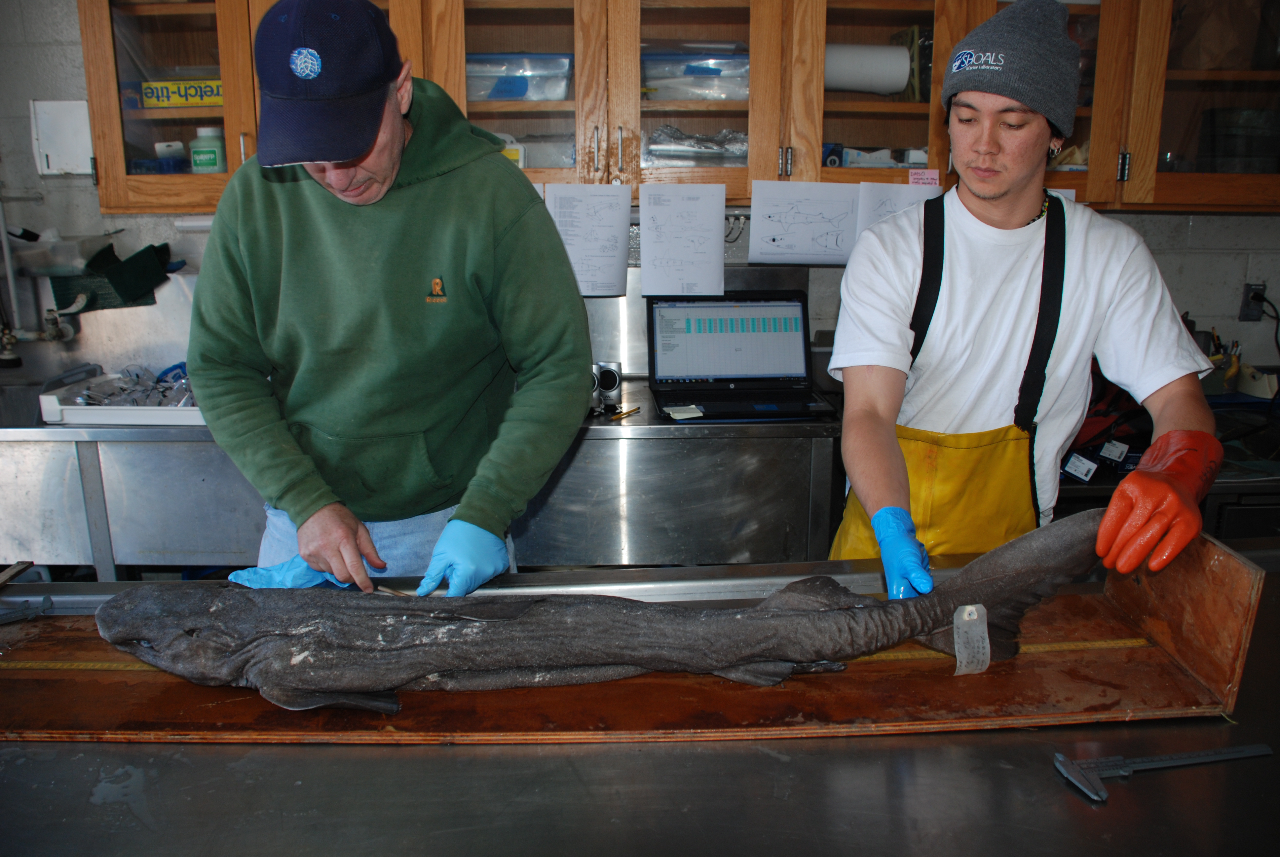Science News
Fantastic Voyage
October 16, 2012
by Barbara Tannenbaum

On a recent autumn morning, Dave Ebert (pictured, left), an Academy research associate based in Moss Landing, California, backed his truck into the Academy’s loading dock. Working with graduate student Paul Clerkin (pictured, right), they unloaded several heavy tanks filled with the larger deep-sea shark specimens that Clerkin had collected during an expedition to the southern Indian Ocean. As they transferred the new specimens into the Academy’s ichthyology collection, final confirmation that ultimately would add eight new shark species from a little-known area of the world drew closer.
It took Ebert, who also serves as director of the Pacific Shark Research Center at the Moss Landing Marine Laboratories, two years to organize the expedition that sent the 27-year-old graduate student aboard a New Zealand-flagged fishing vessel, the Will Watch, in late February 2012. During the voyage that set sail from the island of Mauritius some 560 miles east of Madagascar, Clerkin collected nearly 400 specimens, including 25 to 30 representatives of known, but rarely seen, chondrichthyan species (cartilaginous fish such as sharks, rays, and chimaeras). Those sharks were found at depths from 800 to 1600 meters [2,600 to over 5,000 feet] deep and ranged in length from one to five feet.
“It’s a cliché to say that three-quarters of the Earth is covered with water,” says Ebert, who has researched chondrichthyans throughout the world’s oceans for more than twenty-five years. “But the truth is, the southern Indian Ocean is very remote and relatively little known. It has never been properly explored.”
Ebert’s interest was piqued in 2010 when a colleague at the United Nation’s Food and Agricultural Organization, focusing on the biodiversity in the southern Indian Ocean, requested his help to identify photos of some unusual chondrichthyans.
“Commercial fishermen were catching unusual sharks and wondered what they were,” he says. “Visually, their differences were obvious,” says the author of more than 300 publications and 12 books on chondrichthyans. “Clearly the region deserved further study.”
The next step, Ebert says, came when an executive from the Southern Indian Ocean Deepsea Fishers Association (SIODFA) contacted him several months later to gauge his interest in collaborating with SIODFA and the Republic of Mauritius’ Department of Fisheries. “It was a great idea,” he says, “but I needed to find a graduate student with considerable ocean-going experience who would not mind being at sea for two to three months.” In other words, a role that Ebert once fulfilled as a graduate student under the mentorship of the Academy’s senior scientist, John McCosker.
As Ebert pondered logistics, he turned his attention to financing the venture. A colleague had received funding from the National Science Foundation to work on phase two of the Chondrichthyan Tree of Life, an effort to catalogue and map the geographical diversity of sharks and rays. Ebert proposed the expedition would be a good fit and his colleague agreed the project would likely yield valuable data, and possibly new species.
There still remained the need for a qualified graduate student. Enter Paul Clerkin, a Cornell University graduate, who applied to work with Ebert at Moss Landing Marine Laboratories for his M.S. degree. “I have nine graduate students working on numerous projects,” Ebert says. “I picked Paul for his unique experience as a NOAA storm tracker and National Marine Fisheries Service certified observer in the Bering Sea.”
“I launched Paul on a crash course in identifying deep-sea chondrichthyans,” Ebert laughs. “Since I expected him to see new or unusual species, I wanted him to identify his species to the genus level if possible.”
Clerkin recalls the demanding protocol he followed to document the fish. “The number of sharks they caught as bycatch changed daily,” he says. “Sometimes I sampled five sharks all day, other times there were hundreds. I tried to document every shark that came onboard. However, there were hectic days when I only had time to take gender and length from the common sharks so I could perform detailed measurements on the rare ones.”
Ebert explains that adding the specimens to the Academy’s collection will enable international experts to review their work, a step as important in the discovery of new species as publishing one’s findings. Scientists have validated the discovery of approximately 150 new species of fish per year.
The Academy’s ichthyology collection and Catalog of Fishes database is renowned in scientific circles. According to Dave Catania, collections manager, the Academy holds 230,000 specimens representing 12,000 species of marine and freshwater fish. Of those, the Academy holds about 2000 scientifically significant, name-bearing type specimens.
“It’s best to think of our collection as a lending library,” Catania says. “Throughout the year, researchers arrive to study these specimens in our wet labs. Others need us to ship these specimens to laboratories around the world.”
Ebert adds, “We know that some of the specimens that Paul found are extremely rare. There’s a handful that we’re dead-on certain are like nothing we’ve ever seen.”
The transfer complete, Ebert takes off his baseball hat and grins broadly. “The Academy has been right there on the forefront of leading expeditions and naming new species. It’s a great time to get into the field and see what’s out there.”
Clerkin nods in agreement. For now, however, they climb back in the truck, eager to return to Moss Landing by nightfall.
Barbara Tannenbaum is a science writer working with the Academy's Digital Engagement Studio. Her work has appeared in the New York Times, San Francisco Magazine and many other publications.